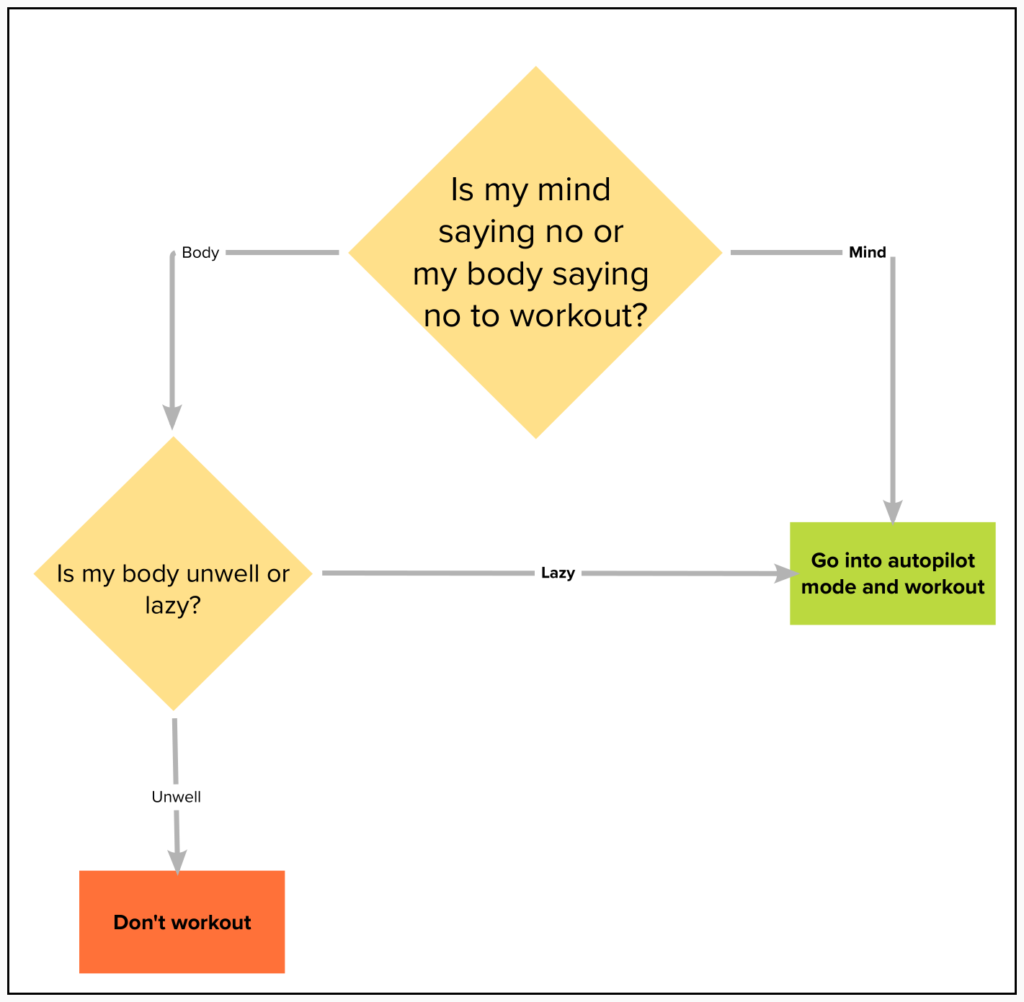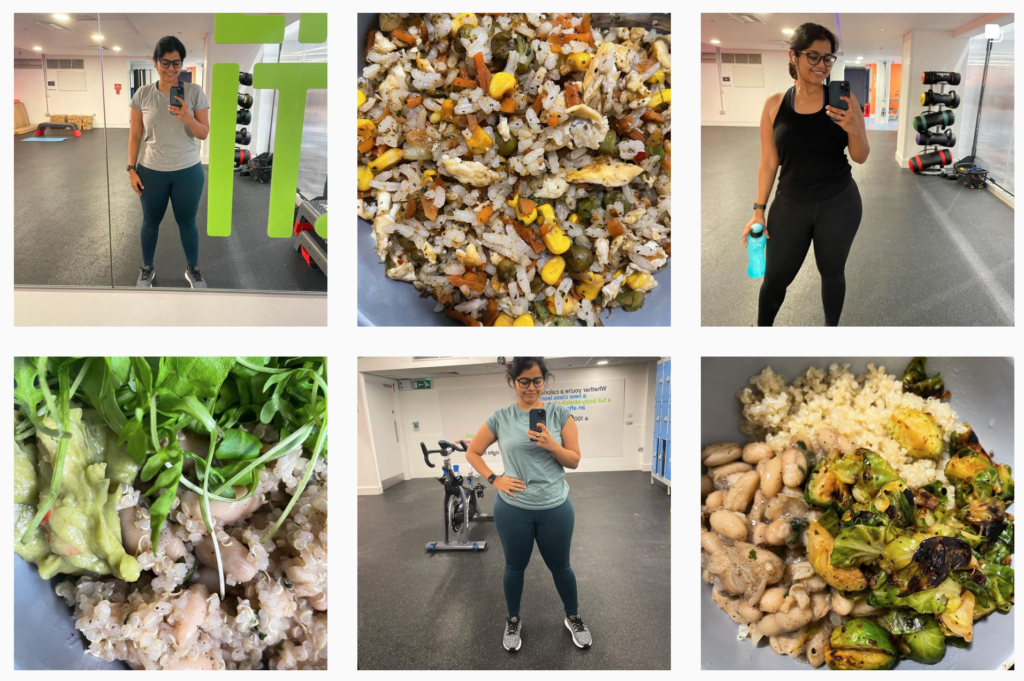This question was asked by Sukriti, a good friend of mine over Instagram Q&A. Because this merits a longer post, writing my response as a blog post! Thanks, Sukriti for the prompt 🙂
About my journey

Aug 13, 2020 (88 kg) 
Dec 22, 2021 (72 kg)
I started my fitness journey in August 2020 with a starting weight of 88kgs. At that time, I could not even recognise myself in the mirror. I had tummy roles, my face was chubby, my clothes didn’t fit me and I’d get constant headaches. So I felt the need to shed some weight. My intention then was to just lose weight and look better so that I feel more like myself.
I did an extreme diet program and lost 16kgs in 4 months. Naturally, all this weight crept back up. I gained half of it back and was at 74kgs in a year. I felt super weak when I had to list my grocery bags and walk for 20-30 minutes. That was the impetus to now start the second phase of my fitness journey to build strength.
I’m currently 72kgs and my intention now is to build lifestyle changes and to love exercising and moving my body so that I sustain these changes for life.
What helps me
Having a clear why and being internally motivated
I think in both phases, I had a clear reason for why I’m doing what I’m doing. As we progress along the journey, this why keeps evolving as our fitness levels also increase. But I find it important to constantly remind us of the reasons why we think we want to engage in activities that improve our health.
Associating positive emotions with fitness
During the Amura program, I focussed only on the number on the weighing scale. I was obsessed with the grams and kilograms I lost to the point that even a slight increase in that number would ruin my mood during the day. Because I felt that I’m suffering to lose weight.. and instead I’m just gaining weight.
This and obsession with the outcome was wrong. It just makes the journey depressing and stressful. But since fitness is for life, it’s important to associate positive feelings and emotions with all things fitness.
It is important that we feel like this is a process of nourishing our body as against feeling like this is torture to just lose weight. These days I try to consciously talk to myself about how I’m positively evolving my fitness, especially when I hate the exercise and feel like giving up.
Focussing on the process and not outcomes
I believe in setting a goal and then forgetting about it. I start my fitness journey for a certain goal, but then once I identify the necessary day to day activities I must undertake to hit my goal, I forget about the goal and just focus on the day-to-day.
For instance, I try to eat healthy throughout the week, and I allow myself to eat out 3 times a week. (I make relatively healthy food choices then). I focus on exercising 3-5 times a week and drinking 2-3 L of water a day.
During the day, I only think about eating well, drinking water and exercising/resting enough. I don’t obsess about what my weight is or how many inches I lost.
Aiming for not zero
I feel doing some kind of movement every day helps. Even if it walking a bit or stretching. I sometimes go to the gym and do the easiest exercises just to move my body. Because my objective as a beginner is to just make the habit of moving my body. It doesn’t matter to me now, how much I’m pushing myself. But it matters that I show up. So I prioritise that habit building and I make the workouts easy so that I feel like going consistently.
Setting goal ranges
I found it super useful to set goal ranges instead of absolute numbers. It is way more realistic that we can exercise 3-5 times a week, than saying we will definitely exercise 4 times a week. The problem with a number is that if you don’t hit the number, you feel like a failure. But with ranges, your chances of feeling successful increase and the sinking feeling of failure reduces.
Making sustainable choices
During my Amura diet, I would measure my weight every single day. I used to record every meal I ate and I would measure my calorie intake every day. When I was doing all this, I was only working part-time as a consultant and I had my mother helping me in preparing meals. Naturally, at the end of 4 months, I got sick of it and stopped all of that!
This is not sustainable. So what I do now is make largely healthy choices – quinoa instead of rice, multigrain tortilla instead of a white tortilla, oat milk instead of milk, brown sugar or stevia in place of sugar, fruits in place of desserts, etc.
I don’t deprive myself of these, but I make relatively healthy choices that I can sustain over time.
Making it easy for making healthy choices
It is critical for me to enjoy my food. I hence only eat the food I enjoy and I put in the effort to feed myself tasty food with enough variety included.
I also cook building blocks for my meals which I mix and match to form various meals. This way I’m not eating the same meal every day, but I’m still eating healthy (boiling quinoa, sauteing vegetables, making subzi, etc).
I also stock pre-cut fruits, protein bars, greek yoghurt, wheat crackers, hummus and guacamole for snacks.
Going into autopilot when I don’t feel like working out
This is a big one! There are days when I don’t feel like working out. Or I will overthink if I should workout considering my work bandwidth etc.

Then I use the following framework to decide. My autopilot mode is basically shutting the mind off and following the checklist – change to workout clothes, wear shoes, fill the water bottle, leave the house, enter the gym, get on the elliptical machine.
Documenting my journey
I enjoy posting my progress pictures and food log on Instagram, @goodbyegundu. This is just for me to look at my journey and reflect on it. In some way, this helps me look at my past progress and see how far I have come to motivate myself.

Allowing Flexibility
I do not put out workout clothes the day before. I don’t make myself feel like I’m forced to work out. I don’t force myself to go at the same time to the gym or to eat the exact number of calories a day.
I have a busy schedule with classes at LSE and schoolwork. So I choose to not pressure myself more with these unnecessary constraints. As long as I want to work out, I know that I’ll do whatever I can to make it happen – and that drive of mine is what I count on.